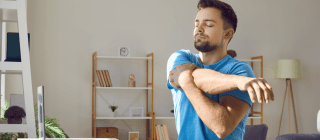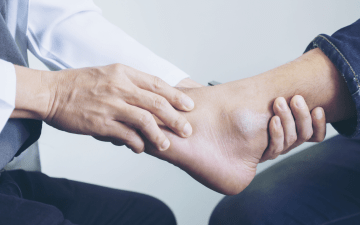You Can Exercise While You Work

Sitting for long periods of time can negatively impact your health. Learn how to stretch and do other exercises at your workstation to help offset those impacts.
It can be difficult to find time to exercise during the workday. Phone calls, meetings, and deadlines all conspire to keep us seated at our workstations for hours. In fact, nearly half of workers never take a break during their workday, according to a survey.
Remote work has further reduced opportunities for workday exercise. Roaming around the office to talk with colleagues and walking to meetings have been eliminated with remote work. Even the brief stroll from the parking lot to the office building has vanished. As a result, remote workers tend to be more sedentary, with people working at home spending two more hours a day sitting than people who don’t work remotely, researchers at Stanford University found.
A busy schedule or remote work shouldn’t deprive you of receiving the benefits of exercise during your workday. You can stretch and do other exercises while remaining at your workstation and staying productive. We’ll tell you how, and give you a new educational program for strengthening your back and preventing low back injuries.
Why Sitting is Bad for Your Health
Sitting for long periods of time has been linked to increased risk of:
- Diabetes
- High blood pressure
- Heart disease
- Obesity
- Cancer
- Back pain and sciatica
- Digestive problems
- Blood clots
- Stress and anxiety
Not only does prolonged sitting increase your chances of developing one or more chronic conditions, it also increases your risk of dying prematurely. People who sit for more than eight hours a day with no physical activity have the same risk of dying as people who smoke or are obese, researchers have found.
The good news is that moderate amounts of exercise can help offset the negative impact of sitting. Using your muscles during the workday burns calories, and that helps reduce fat deposits that can lead to many health problems. Even small amounts of exercise, done frequently throughout the day, can be effective in improving your health and preventing illnesses.
Micro-workouts Break Up Sitting
Visiting the local gym or spending an hour on your home exercise equipment are great ways of working out, but there are other methods of getting exercise that involve less of a time commitment.
Micro-workouts, also known as exercise snacks, are brief bursts of physical activity that you can do during your day. They can be as short as a minute or as long as 15 minutes. You can do them at your desk or anywhere else. They can be done with or without equipment.
The goal is to break up long periods of sitting and get your muscles moving for a few minutes. You can use micro-workouts to supplement your regular workout, especially on days when you don’t have time for your full routine. Several micro-workouts spread throughout the day can add up to a full workout.
Examples of micro-workouts that don’t require equipment include:
- 3 minutes of jogging in place
- 50 jumping jacks
- 10 push ups
- 2 minutes of alternating lunges
- 20 squats
- 1 minute of calf raises (standing and lifting your heels to work the calf muscles)
- Dancing to a song (be sure to wear headphones to avoid disturbing coworkers!)
You can combine several of these into a short routine. Create some fixed sets or mix them up on the fly to keep it fresh.
Adding a few basic pieces of equipment will enable you to expand the variety of your micro-workouts. This can include:
- Kettlebells kept at your desk that you can pick up and swing throughout the day.
- Resistance bands that you can pull for a few minutes, several times a day. There are many simple exercises that can be done with resistance bands, such as standing on a band with both feet, grasping each end of the band, and pulling up in a curl to work your upper body muscles.
- Sturdy chairs (without wheels) can be used to do chair dips. Sit on the edge of a chair, with your hands grasping the sides of the seat. Extend your legs out but keep your feet flat on the floor, then bend your elbows and slowly lower your body to the floor. Use your arms to push yourself back up on the seat and then repeat.
If you work in an office environment and would rather not do exercises that will attract attention, here are some exercises you can do without anyone noticing:
- Butt clenches — Squeeze your glute muscles and hold for a few seconds. You can do this sitting or standing.
- Desk pushes — Place your hands on your desk and try to push it down into the floor, which engages your core muscles.
- Hand presses — Put your palms together in front of your chest, with your elbows out to your sides. Push your palms into each other as hard as you can and hold for a few seconds. Try to work up to 10 seconds per repetition.
- Thigh presses — While sitting, place your palms on the outside of your knees and then try to open your legs, pushing your knees into your palms.
Strong Back, Strong Future
We mentioned earlier in the article that prolonged sitting can cause back pain and sciatica. The best way to prevent back pain is to learn how to do low back stretching and strengthening exercises. Our wellness team has put together a “Strong Back, Strong Future” educational program that all Blue Cross VT members have access to through the Be Well Vermont platform. If you’re not familiar with Be Well Vermont, check out this video to learn more about its features and capabilities.
Blue Cross VT has partnered with Injury & Health Management Solutions, Inc., of Williston to develop the program. You’ll get expert advice and proven strategies to support a healthier back and a brighter future. Included are short videos on:
- Low back stretches
- Low back strengthening exercises
- Office ergonomics
- Safe lifting
- When to seek help
If you don’t already have an account on the Be Well Vermont platform, click here to get started. It’s free for all Blue Cross VT members! You’ll need your member ID number to create an account. Once your account is created, click the “Health” icon on the top menu bar, select “Journeys,” scroll down to find the “Strong Back, Strong Future” journey, and click the blue start button.



